
“勿失毋忘——雕塑家滑田友诞辰120周年纪念展”从策划到落实历时一年多,已于11月24日在中央美术学院美术馆开幕,展期一个月。这里仅就展览从无到有的过程与要点加以回溯,以为工作交流和存档的展览策划志。
一 / 勿失毋忘
“勿失毋忘”作为雕塑家滑田友诞辰120周年纪念展的主题,它的提出与展览的诞辰纪念性质密不可分。或者说,它的提出非常恰当地应和了展览的诞辰纪念性质。但之所以提出这四个字,却不是一时的灵光乍现,凭空生造出来,而是有它确切的实物来源和情感逻辑。
在最初的案头工作时,我注意到家属提供的电子资料中有十几个小本子。这些小本子普遍也就巴掌大小,大部分是滑田友1933—1948年在法国学习生活15年后带回来的,滑田友在上面多用铅笔书写文字或勾画形象,属于是那种不怎么讲究逻辑和章法、翻开看哪里合用就写在哪里的随手记录,因而字迹也比较自我,外人辨识起来相对会比较费劲费时。在这些属于个人学习记事的小本子里,有一本让人印象深刻。在这一本上,滑田友不仅在封面题了 “勿失毋忘” 四个字,而且还对这四个字的字体与摆放位置做了一番精心的加工和设计,形成一种别具一格的视觉美感(图1)。而翻看这个本子的内容,则主要记录的是滑田友讨论“气韵生动”的《六法新释》片段、参观埃菲尔铁塔附近博物院亚细亚陈列室的器具而想到改良的心得以及中国历代纪年表等,都是不过百字的片言只语或者抄写。日后虽然我还不断翻阅过滑田友的其他材料,但这个小本子上面设计的那四个美术字却令人过目难忘,好像冥冥之中触摸到了一点什么东西。

图1 滑田友学习记事本 图片来自家属
与此同时,我也在了解滑田友研究的学术史,其中,有位基层文保干部在几度回忆滑田友与甪直保圣寺的文章里所提及他亲历的一件往事尤其令人感慨。这位文保干部说,在1978年国庆前夕,已是古稀暮年的滑田友偕夫人背着胶泥石膏,千里迢迢从北京赶到苏州,干嘛呢?决心完成他久埋心底的夙愿——修复1961年他在保圣寺看到的一尊罗汉像。但当滑田友满怀希望来到保圣寺,跨入罗汉堂,看到他想修的那尊塑像在十年浩劫中又历经新的毁坏,顿感已无回天之力,一时情不自禁,面对残像竟号啕大哭起来,这悲号令在场者神色凄然,想劝慰滑田友也劝不住[1]。滑田友为什么哭得如此伤心?从残像难修到文保干部描述的滑田友和甪直保圣寺的渊源以及青年滑田友在此曾经的家破人亡故事,似乎都已给出了答案。但是我想,从滑田友1930年第一次来到甪直修复保圣寺罗汉堂塑壁,到这一次,也是最后一次,在经过近半个世纪的雕塑人生后,垂垂老矣的滑田友在重又回到他青年时期艺术起步处的这一哭,让人觉得他心底曾经的凄苦,酸涩绵长。由此,不由得又想到他那小本子上独特的四个字“勿失毋忘”。
“勿失毋忘”,是青年滑田友最初书写在他留学法国时的小本子上的四个字,是老人滑田友在甪直保圣寺残像前从心底里喷涌而出的两行泪,这是确确实实发生在滑田友身上的故事,而且二者之间似乎也有可以触摸的前后一致的情感逻辑,尽管我到现在也不知道滑田友当时因何而隆重地在小本子写下这四个字,但这四个字上所凝结的情感在终其一生的人生逻辑里却令人感慨万千,深感它为策划诞辰120周年纪念展提供了可以储蓄复杂信息的叙事空间和情感空间。由此,我觉得未来的展览应该就从这四个字上去立意和深入,其主题名称应该是“勿失毋忘——雕塑家滑田友诞辰120周年纪念展”。
二 / 剧本六章
“勿失毋忘”作为雕塑家滑田友诞辰120周年纪念展的主题,是立意是基调,而对于如何切题搭调,在最初编剧构思时实际上有个副题,即“雕塑家滑田友的动心处”。但做展览毕竟不是写文章,所以为了不把展览名称整得像篇文章题目,为了求得简明利落,在最后确定的展览名称里我直接删掉了副题,但在具体的编剧工作中却始终还是以“雕塑家滑田友的动心处”为抓手,去组织和编辑材料,以反映“勿失毋忘”的主题。
“勿失毋忘”关乎记忆和珍重,因此在滑田友的艺术人生中哪些是令他心动的所在,就需要在已有的研究和材料中,特别是在与家属沟通所获材料和认识中提取。最终,基于对滑田友艺术人生的理解,我提出了一个首尾逻辑呼应、中间依次展开的讲述滑田友艺术心动的六章剧本,其基本内容和结构为:①序——田友自述。②雕塑思想史——滑田友雕塑艺术之道。③田野考察记——滑田友调研传统之路。④教学方法论——滑田友雕塑教学之得。⑤艺术世界观——滑田友外版藏书之见。⑥结——田友心结。
关于①序——田友自述,就目前所见,滑田友公开发表的自述只有一份,当然他一生中在不同的历史语境中不止写过这一份自述。但这一份,一是写于1947 年,写得比较早,二是在1950年以前就已公开发表过不止一次。在这篇曾发表于1947年第12期《世界月刊》的自述《我学习雕刻的经过》(图2)里,滑田友全面回顾了他由出生到从法国回国前的雕塑学习和创作历程,例数他在法国的重要雕塑创作与奖项,堪称一份他告别十五年在法留学生活,满怀希望地投身祖国怀抱时递交的自我介绍信和成绩说明书。以这篇动心的自述为中心引子,编剧时结合滑田友从淮阴、甪直到巴黎、北平一路走过来的照片、通信、证件、证书等,演示他出国前、在法国、回国初的社会生活历程。其中比较重要的几部分材料包括滑田友存早期雕像《小儿肖像》(扩印图片)等以及在国内创作但带到法国铸铜的《诗人陈散原像》(图3),滑田友存修复甪直保圣寺罗汉堂塑壁照片(扩印图片),滑田友存赴法国生活学习的证件(图4)以及合影照片(扩印图片),徐悲鸿与滑田友回国前后的数封通信原件,滑田友在法国使用的照相机等。通过上述资料的编辑,既具体呈现滑田友步入雕塑之路的求学轨迹和社会行程中那些令他难忘的人和事,又为之后的单元做必要的历史铺垫,试图尽量由此引发观众观展的兴致。
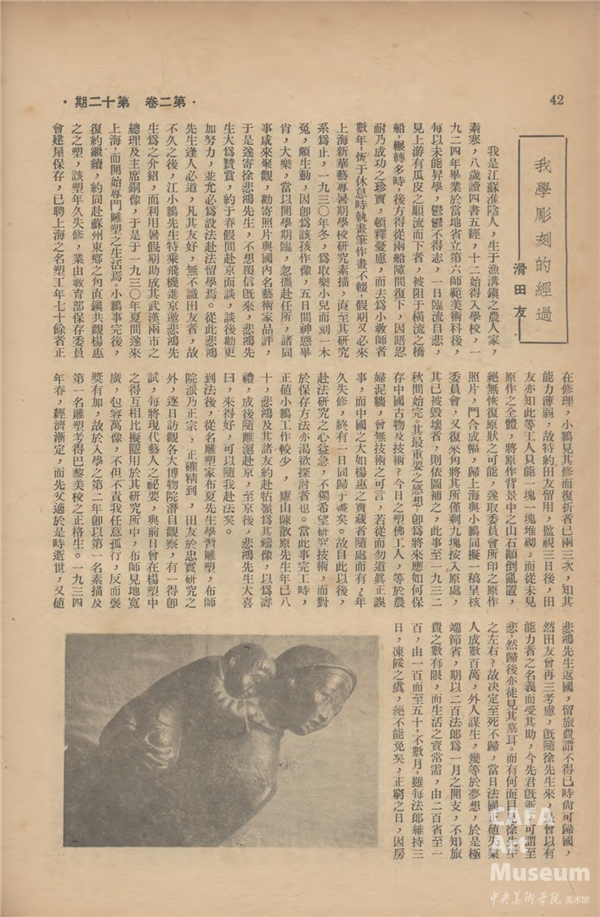
图2 滑田友《我学雕刻的经过》 图片来自数据库

图3 滑田友《陈散原像》 图片来自展览

图4 滑田友留法国时期的博物馆参观证 图片来自展览
关于②雕塑思想史——滑田友雕塑艺术之道。滑田友的雕塑艺术之道,主要通过滑田友的代表性雕塑(以人物为塑造对象和表现主题的石膏、铸铜与照片,如《出浴身段》石膏像(图5-6)、《沉思》铜像、《轰炸》铜像、《少年中国》塑像照片、《五四运动》石膏浮雕头像等),并兼及他不为人所熟悉和常见的绘画(主要是他留学法国时以人物为表现对象的墨笔纸本写生以及少量素描、中国画)(图7),反映滑田友雕塑艺术的总体发展路程,这是所谓雕塑艺术之道的最为基础和直接的意思。在此基础上,本单元之所以特别明确雕塑思想史这一主旨,主要基于艺术家艺术实践与中西、与人生两方面的考虑,因为这两方面是滑田友雕塑思想史,其实也是中国现代雕塑思想史上两个最为基本和核心的大问题。作为个案而言,滑田友雕塑艺术实践与中西艺术传统的关系问题,亦即创作语言问题,学术界至今对其有“以中化西”“以西致中”不同倾向的理解和认识,而与时代人生的关系问题,亦即创作内容问题,滑田友在雕塑创作上从20世纪30年代就开始呈现出对人与时代倾注深沉积极的现实关怀的心动面,且一以贯之地体现出文以载道、关怀人生的自觉倾向,这一点已为同仁所共识。内容上传达悲天悯人、渴盼国泰民安的一贯性使得滑田友的雕塑艺术不能机械地为新旧社会、国内国外所区分,而且也只有在完整统一的逻辑里才能更好地掂对他的语言问题,因此,对滑田友雕塑思想史的理解就必须建立在完整地看他的创作逻辑上,此即展览时需要将滑田友雕塑创作集中一体展示的认识基础。

图5 滑田友《出浴身段》正面 图片来自展览

图6 滑田友《出浴身段》侧面 图片来自展览
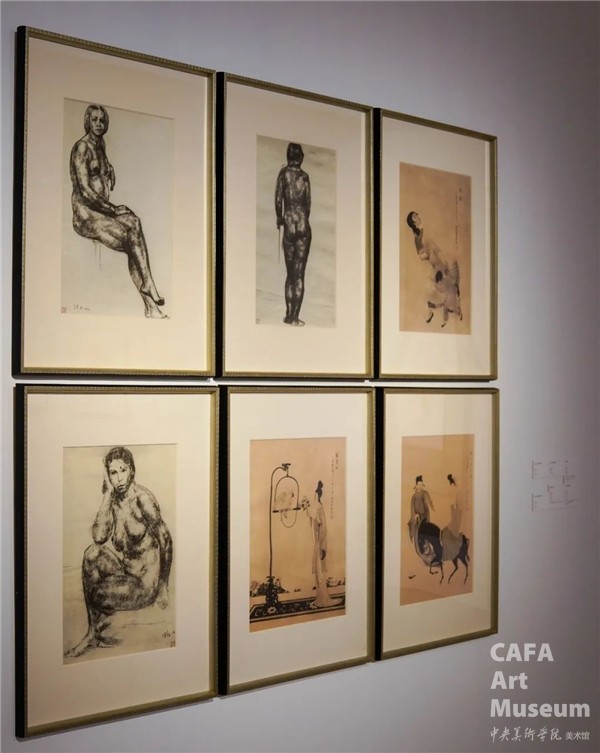
图7 滑田友在法国完成的素描与中国画(六件均为复制品) 图片来自展览
其实,作为一个人完整的雕塑思想史并不仅仅体现在他的创作上,滑田友的教研、读书、行路也都相关于他的雕塑思想史,只是由于过去没有像现在这样的展览研究意识,不可能从这些方面向社会和学术研究领域呈现更丰富更直观的物证材料,从而影响了对滑田友雕塑思想史,说大一些也可以说是对滑田友这一代艺术家思想史的认识。一个人的思想当然会延展到他社会生活的方方面面,这本来就是一个不用专门讨论的常识。对于近现代中国美术研究来说,尽管社会发生了翻天覆地的变化,但艺术家的社会生活相比更古老的时代相对还较容易被理解和被触摸,只要有所意识,在作品之外丰富多样的社会生活——比如涉及柴米油盐酱醋茶的生活史(诸如户口本、工资条、医疗卡……),涉及喜怒哀乐悲欢离合的情感史(日记本、书信、自述……),涉及个人爱好与品味的收藏史(图书杂志、音乐卡碟、书画收藏……),涉及个人工作岗位的职业史(会议发言、采风考察、教学总结……)——都还能够有所搜集和收获,反过来都有助于我们讨论和理解一个人的思想处境和内核形成,有助于我们更客观地把握一些思想线索。基于这种认识,这些年在做艺术家文献展时,我所带领的策展团队往往愿意从过去不为人知或所知不多的历史面向上去努力,尽可能在与家属、与各部门的沟通基础上,将有用于了解艺术家思想痕迹的物料通过展览编剧呈现出来。
本次展览对“③田野考察记——滑田友调研传统之路”“④教学方法论——滑田友雕塑教学之得”“⑤艺术世界观——滑田友外版藏书之见”等单元内容的专列,既是如此想法下的工作实施,同时也是对“②雕塑思想史——滑田友雕塑艺术之道”的补充和深入。
滑田友的田野考察在20世纪五六十年代有两次,1953年主要在华北、西北、山东等地,十年后的1962、1963年主要在四川、江苏等地。滑田友有读书的习惯,日本学者大村西崖著《中国美术史》中的部分篇章被滑田友在边边角角写得密密麻麻。在对当地石窟寺庙的造像调研后,滑田友大致形成了他对中国历代雕塑史脉的认识,也明确体会到中西传统造型风格不同的关键。他这样谈到:
中国古代的艺术之所以有这样的优秀作品,有这样的宣传力量,主要是注意描写精神面貌,以形写神。所谓形,是指描写人的面形或人和物的整体及动作的形。描写时不是为了形而形,也不是写实的形,而是根据实际的形象和思想感情结合起来,综合概括出来的‘应物象形’的形,有时是采用夸张的或简化的手法把原来的特点有所取舍的表现出来的形。所谓取,就是取其实际突出的部分,甚至夸张一点使其更突出;舍,就是实际形上不突出的部分,根据需要去掉,使之更不显著,这样使人感到形象更为明确有力,直到形象已突出的表达了精神面貌,或形象已不成问题,立即转入作品的思想内容的玩味和体会。这就是中国古代作品的优点,即中国传统风格和西方传统风格的不同之处。[2]
目前在他的遗存文稿中有涉及山东、山西和陕西诸省的华北调研行程路线图以及访问云冈、麦积山、大足等石窟的观感文字,其中只有《传统与继承——四川访古随感(1963年6月-7月)在1993年被整理公开在他的画集中。除此之外,作为艺术家和考察者,滑田友在各地调研考察时还拍摄了许多照片资料。就目前所见,在中央美术学院滑田友这一批老艺术家中,滑田友的照相机装备(图8)更齐整,所拍摄的雕塑资料也较多。这些资料,有些我们耳熟能详,特别是石窟,大概一看便知,而有些资料,尤其是寺庙,虽对其风格手法不觉陌生,但具体所在为某地以及是否还存世人间则需要考订。此次展览时将这批照片按地域归属与相应的文稿一体陈列,主要是希望从视觉图片和心得文字两方面展现滑田友对中国传统雕塑调研的心动面。

图8 滑田友的相机 图片来自展览
雕塑教学是滑田友从事了三十多年的工作,通过这一工作,滑田友将自己对雕塑艺术的理解进行了理论和经验方面的总结。以传统的“六法”理论来认识和指导雕塑发展,六法雕塑化,古为今用;以日常生活经验转化欧洲学院雕塑形体学理论,术语本土化,洋为中用——这是滑田友雕塑基础教学上的特点。他在教学过程中强调的或言说的“贯气”“编筐子”“串冰糖葫芦”“铺石子路”“看山”“八根线”“一段段的好风景”等教学术语,因其生动、形象和具体而始终为他的同事和学生津津乐道,并作为一种认识雕塑的经验不断被强调和传播。他对雕塑基本训练的系统看法,实际上也就是雕塑系教学大纲的基础,其中思想性、基本功和艺术性的完整统一,运动规律、组织规律和技巧训练的系统掌握,依旧是现在雕塑基础教学所秉承和强调的主要方面。本单元以“教学方法论——滑田友雕塑教学之得”为题,主要通过四组富有视觉表现力和说明性的照片,如滑田友自摆坐像动作(图9)以呈现动态和衣纹的一组照片以及他创作完成并着手拍摄的《宣传者》《中国人民站起来了》《游击队员》等泥塑360°的环拍照片,结合滑田友《我对雕塑基本训练的看法》《我怎样教雕塑实习》等文稿,突出明示他富有个人经验的那些教学术语,尽可能视觉化地呈现滑田友雕塑基础教学的心动面,进而也丰富对滑田友雕塑思想史的进一步认识。

图9 滑田友自摆坐像动作 图片来自展览
私人藏书或影集,始终是我策划史料性、研究性展览中留意和关心的主要方面。2015—2016年在策划滑田友同学和同事的王临乙王合内的展览——《至爱之塑——雕塑家王临乙王合内夫妇作品文献纪念展》时,我团队主要挖掘并公开了王临乙王合内私人影集中的史料关键部分。此次,我团队在与家属沟通中获悉滑田友藏书情况后即着手安排著录,特别是对滑田友旧藏外版图书关注和调查尤多。图书是艺术家的思想链接艺术世界的桥梁,而由艺术家选择哪些书籍购买和阅读可以感知到他的艺术世界观。在滑田友旧藏的外版艺术图书中大约有八十多种法文版,其他西文版如德、俄、保加利亚等艺术图书有三十余种,涉及艺术史、艺术家以及博物馆对雕塑、建筑、绘画的编研,后者如20世纪二三十年代出版的《艺术世界百科全书》ENCYCLOPÉDIE PHOTOGRAPHIQUE DE L'ART卢浮宫博物馆古美索不达米亚艺术、希腊罗马雕塑、埃及文物等系列,《吉美博物馆年鉴》ANNALES DU MUSÉE GUIMET中国雕塑绘画建筑、远东艺术、亚洲艺术等系列,《美国藏中国绘画》LES PEINTURES CHINOISES DANS LES COLLECTIONS AM.RICAINES。艺术史方面如《法国艺术通史》HISTOIRE GÉNÉRALE DE L'ART FRANÇAIS、《现代艺术》L'ART DANS LA VIE MODERNE,《阿波罗——卢浮宫学院教授的造型艺术通史》APOLLO-HISTOIRE GÉNÉRALE DES ARTS PLASTIQUES PROFESSÉE A L'ÉCOLE DU LOUVRE等。艺术家方面如达芬奇LÉONARD DE VINCI、米开朗琪罗MICHEL ANGE、安格尔INGRES、罗丹AUGUSTE RODIN(图10)、布德尔ANTOINE BOURDELLE、梵高VAN GOGH、马蒂斯MATISSE等。从中可见滑田友通过博物馆对中国、远东、中东、欧洲艺术资源的了解,对触动人心、有形式意味的写实雕塑传统的钟爱。毫无疑问,对这一部分资源的触及极有利于我们深入了解滑田友的雕塑思想史。

图10 滑田友藏罗丹雕塑集 图片来自家属
由前半生的自述作为引子,从一生的雕塑创作代表作到20世纪五六十年代的中国传统雕塑考察,从归国后的雕塑教学方法谈到他1948年从法国留学1957年外访保加利亚带回的外版艺术图书所见艺术世界,剧本一直通过抓取令滑田友动心的地方以回应勿失毋忘的主题,但滑田友最让我感到内心翻腾的是他暮年在甪直保圣寺残像前的那场号哭,现在想起来,不妨说就是这个情节决定了我对勿失毋忘这个主题的选择。虽然滑田友之哭事出有因——塑像旧残未去又添新伤,但若总体地看,又不纯然是这一个原因在起作用,我以为是他从淮阴、上海、甪直、巴黎到北京,从青年、壮年到暮年,这一路深一脚浅一脚的人生路上所积郁起来的全部勿失毋忘的辛苦、遗憾和珍重的感情在起作用,这就要求在展览尾声呼应前引自述,给一个结作为交代,给一个从甪直出发回到甪直的粉墙竹影的视频意象(图11),给一个在所有江苏人的视听文化记忆里都能熟悉起唱的民间曲调《秦淮景》。剧本为此写道:
甪直
苏州东南五十里外的一个水乡古镇
青年滑田友曾在这里修复保圣寺罗汉堂
这里是他难以忘怀的地方
光阴如白驹过隙
走过法国寒窗留学的冬去春来
经过回国发展雕塑事业的阴晴圆缺
滑田友暮年最后一次来到甪直
见塑像旧残未去又添新伤
情不自禁
放声大哭
人生一世 山重水复
像残人老 泪飞作别
一生所念 悠悠吾心
何以纪之 勿失毋忘

图11 竹影粉墙的意象 图片来自视频
三 / 十处设计
在剧本成型的同时,策展团队一直通过美术馆二层B展厅的现场和地图,推演章节落地的形态和效果,特别是对各章节内容在视觉上的呈现和粘合主要考虑过如下区域和区位的实施,共有十处。
①凹凸带。凹凸带的设计主要是在展览开篇。诞辰纪念展的开篇如何在符合展览对象的艺术气质与逻辑中引人入胜是个难题,若失于推敲,开篇往往有“从前有座山”的平铺直叙感,缺少兴味。此次滑田友展览,开篇为“序——田友自述”,占据的是展厅左侧长墙动线,是从雕塑家交代自己的前半生入手,所采取的是墙上一溜儿20世纪三四十年代的老照片按时间顺序一字码开,与墙下一溜儿长条柜放置滑田友自述《我学雕刻的经过》和实物文献形成图文阅读关系的展陈形式。为使墙上一溜儿照片和雕塑展形成视觉呼应,特别制作有明确凹凸起伏感的立体凸起块粘贴照片,从而形成一条以滑田友为中心的视觉图像凹凸带(图12)。这一设计相对应地即要求展厅右侧长墙动线也与之呼应。按照常规,展厅右侧长墙一般仅放置千字展览前言,而为打破入手即平的视觉感受,突出展览的雕塑内容和属性,我希望沿动线在前言之前即以滑田友常用的雕塑工具设计展柜,让工具展柜向前跨半步“报幕”(图13)。工具报幕的好处一是凸显展览对象作为雕塑家的身份和意志,二是吸引观众追问工具的名称和功能,三是启发雕塑同仁对得心应手的工具开发,四是引起观众对使用这些工具产生怎样雕塑作品的期待。由此,在前言以相应的凹凸块展开之前,首先以两柜平行的雕塑工具向观众宣布,雕塑家滑田友的展览从这里开始了。

图12 以滑田友为中心的视觉图像凹凸带 图片来自展览


图13 让工具展柜向前跨半步“报幕” 图片来自展览
②反嘴鹬。此次展览发生于抗疫时代美术馆经费大规模压缩的时期,本着不违逆雕塑家作品气质同时又节约成本的考虑,我起初就提出美术馆墙面维持四白落地的场馆本色,不再进行大面积的二次涂料粉刷,尽可能将节省的经费用于展览必需的展柜和其他搭建制作,但同时却希望在墙面局部要加以特定元素的装饰,以体现展览是滑田友雕塑展而非其他艺术家雕塑展的识别性。这种特定元素我选定为滑田友1947年创作的黑漆屏风画鸟的形象(图14),特别希望设计在展览空间的关键处和转折处用这种飞舞的形象来装饰和点缀,以强制性地形成飞鸟贯穿全展的印象,从而实现对“勿失毋忘”意境的烘托。有意思的是,正是在讨论过程中,我团队才发现原以为是鹤的飞鸟,其实是模式产地在意大利的一种候鸟——反嘴鹬,因为它那又长又细且上翘的喙与常见鸟类平直或下弯的喙非常不同。最后,飞舞的反嘴鹬被丝网印用于两处设计,一处是选择不同的飞舞姿态与各单元标题结合起来,另一处是展览尾声的一段弧墙上以二方连续构成反嘴鹬飞舞的装饰壁画,以此达到串联展览视觉,实现意境烘托的意图。(图15)

图14 滑田友1947制漆雕屏风 图片来自家属

图15 弧墙上以二方连续构成反嘴鹬飞舞的装饰壁画 图片来自展览
③德邻堂。此次展览展出的雕塑作品主要集中于美术馆二层B展厅的大厅,这个大厅的平面近似直角三角形,其底边、斜边以及它们形成的夹角空间是该展厅常用的三块主墙面,它的视觉特殊性在于沿底边走到夹角空间的进深比较深,但挑高却不太高,空间上越往深处走越紧缩,肉眼可感的透视关系的灭点就是夹角空间的终端墙壁,这对这块墙上作品的比例、分量以及灯光照明系统都有比较特殊的要求。
本次展览启用了滑田友的两件大浮雕,即《工农努力生产建设新中国》和人民英雄纪念碑浮雕《五四运动》。滑田友的《五四运动》在中国家喻户晓,但其《工农努力生产建设新中国》则少见报道。这件创作于1950年—1951年8月的浮雕原为北京党中央礼堂装饰浮雕,后建筑拆除重建而被拆毁,展览动用的是滑田友为培训制作《五四运动》浮雕刻工,以《工农努力生产建设新中国》为操演对象的石刻浮雕技术研习作品。《五四运动》和《工农努力生产建设新中国》的体量须占用直角三角形的斜边展线才够使唤,也才够分量,而沿底边进入展厅直面正对这两件浮雕,从重要程度、时间维度、观赏气度上也都顺当。就此,滑田友在法国完成的雕塑作品就主要集中于底边附近和底边与斜边相对形成的空间里,这样自然形成沿底边进入展厅依动线在底边区域先安排留学法国的雕塑,然后在斜边安排新中国浮雕的符合历史时序的作品顺序和展览逻辑。
但因此带来的问题是,如何处理夹角空间的那面墙?其实团队工作尚未到这一步的时候,有一张老照片就引起过大家的注意,那是1948年滑田友在国立北平艺术专科学校(中央美术学院前身之一)德邻堂举办雕塑展览的一张全景照片,照片取景开阔,当年展览摆放雕塑的形式和作品清晰可见,照片的比例与夹角空间的墙面也合适,当时团队就曾议论过用此照片作为夹角空间墙面设计的内容。眼下,底边和斜边大致内容锁定,底边和斜边所形成的大幅度空间进深又期待夹角空间能出现意想不到的布陈效果,团队因此又将德邻堂的照片提出来反复观看,深入讨论,并开始越来越清晰地认识到这张照片对于展览的内容组织和空间关系的统帅意义。从展览内容组织而言,德邻堂照片的出现为展览通过借景认识时光跨越七十年的光阴提供了真实的图景,而它所处的时间点又准确衔接了上动线的留学法国和下动线的回国创作。从空间关系来说,德邻堂照片的出现满足了底边和斜边夹角空间景深透视的延伸感,从而使得夹角空间墙面因照片的景深透视关系而被打破和穿越,这使得在直角三角形的立边看过去,自然在夹角空间形成一个富有深度的舞台(图16)。由此所形成的景观空间(图17),在视觉上联系了中央美院的校史和滑田友的展览史,雕塑作品又都从德邻堂原境里脱身而出,置于展厅,二者之间构成了一种奇幻而真实的现在与过去的镜像对话关系(图18)。由此,我决定以德邻堂照片作为夹角空间墙面上的内容并以此深度组织展厅的关系。

图16 夹角空间形成一个富有深度的舞台 图片来自展览

图17 以德邻堂为舞台 图片来自展览

图18 镜像对话关系 图片来自展览
④大幕布。德邻堂照片作为夹角空间墙面内容确定以后,要大舞台不要大照片,即不要把喷绘的德邻堂照片贴在墙上了事,而是希望它隆重起来、殿堂起来、统帅起来的主旨随之明确,在我询问夹角空间是否可以悬挂幕布形成舞台得到展览管理可行的回答后,幕布的形态和逻辑开始成为团队关注和设计的重点,真正以舞台大幕拉开、帷幔垂落的视觉效果营造德邻堂成为团队讨论的热点和工作的重点。它不仅在视觉形式上别致,在内容逻辑上也成立,滑田友归国后的人生大幕就是这样拉开的。而随着讨论的深入和展陈布局方案的跟进,德邻堂展厅中滑田友大体量浮雕和中小体量圆雕之间的视觉落差,大小不等的雕塑照片和体量不等的圆雕作品之间的视觉凌乱开始突出,需要有一种有力的支撑和协调元素介入组织成为不得不考虑的问题。出于对软雕塑的理解,我提出扩大对舞台幕布垂蔓的使用(图19),将其作为一种类似于立柱的视觉元素出现在展览的视觉关键处,以起到结构性的视觉撑起作用,同时逐渐将其作为展览的可识别元素,向其他展区蔓延,其中包括对展览开篇主题墙的设计,成为与反嘴鹬一样的贯穿展览的视觉形象。如果说飞舞的反嘴鹬隐喻着东方文明的婀娜,那么垂立的大幕布就象征着西方文明的静穆,滑田友的雕塑代表作里就有这两种气质交相辉映。

图19 扩大对舞台幕布垂蔓的使用 图片来自展览
⑤人头墙。沿德邻堂动线向左前行,进入滑田友的新中国时代,也就是直角三角形的斜边,陈列的是滑田友两件巨大的浮雕代表作《工农努力生产建设新中国》和人民英雄纪念碑《五四运动》浮雕(图20)。这两件作品均得自家属,所不同的是《工农努力生产建设新中国》是拼合组装完整的石雕,高有一米八,长有四米多,重达六吨,为了卸力,均匀分布雕塑对展馆地面的压力,安装时必须加装底层基座,由此构成一件视觉壮观、份量极大的作品。但众人熟悉的《五四运动》,家属藏品只有浮雕人物的石膏头像17件、石雕头像4件以及浮雕构图石膏稿2件和一张浮雕泥塑稿照片,从收藏形态上说是比较分散的,但从创作过程上说却又是粗显步骤的。如何安置这些内容,使之能与《工农努力生产建设新中国》在展览现场等量齐观是个问题。对此,我既希望保留这些材料粗显的创作过程,又希望呈现《五四运动》浮雕创作的大比例大尺幅,最终形成的方案是以《五四运动》浮雕的实际尺幅为标准立背板做框架,将浮雕石膏头像按原作构图位置定点悬挂,形成以头部为动态基准的运动起伏的《五四运动》浮雕人头墙(图21),同时为与《工农努力生产建设新中国》相配比而加装基座。之后沿动线递进石雕头像及浮雕构图稿,最后以等比原作尺幅的浮雕泥塑稿照片——真正体现滑田友作为《五四运动》创作者的创作手法与风格的图像——作为整个创作过程的结束(图22)。想的很完美,但在真正落实人头墙方案的时候一波三折,在我已考虑放弃人头墙并给出妥协方案时,是团队伙伴的坚持不懈,最终实现了既保证十几件石膏浮雕人物头像垂立壁面的安全又体现原初设计意图的人头墙方案。

图20 直角三角形斜边墙上滑田友两件巨大的浮雕代表作 图片来自展览
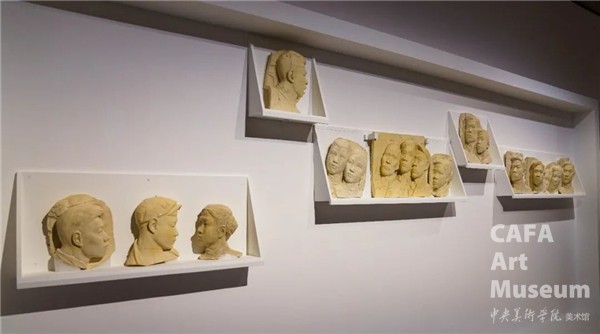
图21 人头墙 图片来自展览
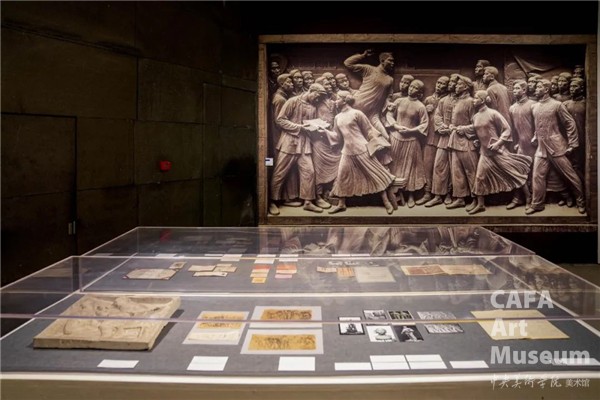
图22 等比原作尺幅的浮雕泥塑稿照片 图片来自展览
⑥抽屉盒。展览反映滑田友对于中国传统雕塑的调查资料主要是他拍摄的一批照片,这批照片在滑田友家藏期间有的依地理归类包扎,有的则因难辨或失记而被混装,其价值一是人物的因素,即经滑田友之眼所摄的不可替代性,其二是文物的因素,即有的可能在滑田友拍摄后的年代里失于科学保护而残损了。如何展示这批有价值的照片,是让观众体会滑田友搜集资料的范围、甘苦和倾心所在,还是从照片资料里精挑细选具有视觉美感的照片让观众欣赏传统雕塑艺术,我认为这次展览应该主要集中在前者。滑田友自己也说过:“我这个抽屉是开着的,等着你们来取。”由此,我提出维持照片资料目前的分类状况并就此装入各自大小不等的抽屉盒(图23),抽屉盒是集纳不是挑选,所以多寡不分,能看即可,也未必每个抽屉盒里都有照片,要通过抽屉盒充分保持并反映照片本身的资料特性。所有的抽屉盒沿动线上墙,抽屉盒大小不一,高低错落,要让观众在看高处或许要垫脚、观低处必须要弯腰的不舒服体验里感受田野考察的辛劳(图24)。

图23 抽屉盒 图片来自展览
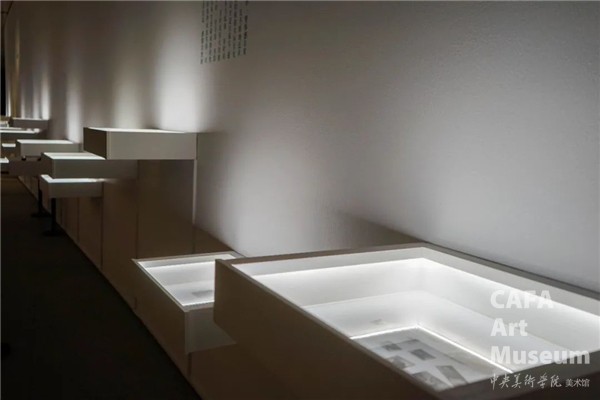
图24 高低错落的抽屉盒 图片来自展览
⑦现翻书。滑田友旧藏外版艺术图书总数有一百二三十种,都拿到展场进行展览既不现实也没必要,但挑选十来二十册用于展示还是可以的,不过即便如此展览也不会允许观众随便翻阅这些旧藏,不能上手翻阅体验对爱书的观众来说是有些遗憾的。为此,我团队主要从两方面解决这个问题,一是从滑田友旧藏中挑选40张雕塑单页装框上墙,以便观众近距离赏读,一是拍摄现翻书的视频,即选择部分重要书籍认真翻阅并现场拍摄视频(图25),由此既解决读者无法翻阅书籍的需要,又体现出对旧藏图书的尊重。


图25-1 滑田友外版藏书 图片来自展览现场

图25-2 现翻书截屏 图片来自展览
⑧江南窗。最后一章“结——田友心结”是通过一个不到三分半钟的视频讲述的,在视频制作的同时,我团队出于遮挡投影设备的考虑,提出在投影前加装月亮门以烘托视觉效果。最终为了更有利于移步换景和聚焦内容,将月亮门落实为圆形窗,后改制为我提议的更富有意象美感的江南窗(图26)。透过这扇窗,观众可以在江苏民歌《秦淮景》的音乐伴随下,看到投屏上的粉墙竹影和剧本文字,看到一个富有江南意象和审美的景观,看到对滑田友这个江苏人一生所爱的感怀。

图26 江南窗 图片来自设计师
⑨记事本。先于展陈设计的海报请柬设计,主要以滑田友签题“勿失毋忘”的记事本为素材来源和设计出发点,完全回避常规的以艺术家头像或作品为元素的构思。海报设计特别突出了记事本作为物品的完整性,不仅聚焦于滑田友签题的“勿失毋忘”,点缀了滑田友的画押小图章,而且同步关切记事本残破的书脊和散开的装订线形成的整体历史感和视觉效果,为此海报设计特别向右偏移了距离,适当让出左侧空间,以充分展开和阅读书籍上的视觉信息(图27)。请柬则进一步依托记事本给与的启发。抗疫时期,预算压缩,为了一柬多用,减少资源浪费,设计按照滑田友小本子的规格,原大制作了纪念与纪事两不误的请柬小本子,新颖实用,别具一格(图28)。

图27 展览海报 图片来自设计师

图28 展览请柬 图片来自设计师
⑩场刊册。编辑场刊小册子是目前纪念展通行的做法,一般往往是对展览结构和内容的选编或精编。此次滑田友展览,我希望纯化展览的视觉语言,贴近主题的视觉诉求,大幅降低文字在展览中的铺陈,仅保留了必不可少的展览前言和展览各单元标题,力求让观众专注于滑田友雕塑艺术的内在品质,与滑田友交流,而非与策展人的各种絮叨文字交流。基于这一想法,此次场刊册子的编辑也力图回避以往常规的做法,其基本原则是展览出现的前言文字,场刊不再收入,场刊编录的文字,展览里概无踪迹。场刊主要内容包括对重点雕塑作品予以简约说明(图29),整理收录的文字有辅助观众了解滑田友教学术语的《教学方法论——滑田友的教学笔记与教学传授编》,有服务观众但主要是为经济展览展线面积而收入场刊的《滑田友年表简编》,同时附有一份交代展览主题想法和结构内容的策展人《关于展览》的说明,希望以充分实现配合而不是重复展览内容的场刊编辑目的,真正凸显和发挥场刊的实用功能。

图29 展览场刊对重点作品的说明 图片来自设计师
04 / 一点遗憾
在策划《勿失毋忘——雕塑家滑田友诞辰120周年纪念展》之前,我曾经策划过的雕塑艺术家展览有《至爱之塑——雕塑家王临乙王合内夫妇作品文献纪念展》《戳心尖尖的泥巴拉话话的魂——刘士铭雕塑艺术展》。通过这些展览,我深感做一个雕塑展览要比做画展费力费心不少。雕塑做展览,大大小小难协调,又沉又重不易动,怕磕怕碰很金贵,要模要样老费灯(给雕塑布光可是不那么容易),这些具体的感受在这次滑田友展览中统统又操演了一遍,其中不乏诸多遗憾,这里仅谈一点感触较深的,当然这一点感触并不都来自于滑田友的雕塑,也来自于曾经策划过的王临乙王合内和刘士铭的雕塑。
目前,对雕塑作品所采取的长期保存方法主要是翻成铸铜。2015年,中央美术学院和中国美术馆合作主办《至爱之塑——雕塑家王临乙王合内夫妇作品文献纪念展》的目的之一,就是通过合作获得项目支持为王临乙王合内的雕塑作品翻制铜像,以便长期保存。在没有策划滑田友雕塑展之前,在中国美术馆、中央美术学院美术馆、中华艺术宫等处所见滑田友家属捐赠的滑田友雕塑代表作,多为铸铜,也是保存和传播滑田友雕塑艺术之想的反映。刘士铭的陶土雕塑也有翻铸为铜,但因其非学院传统的雕塑手法,使他那些颇具社会人文价值和个性风采的黄河船工、窑院等系列代表作,较之滑田友、王临乙王合内等这些他的老师们,翻铸起来更难。
翻铸不可能实现对雕塑在细节信息上的完整保留,这是翻铸技术本身无法克服的遗憾。但若有作者亲自监制,那么还可以有所弥补和调整,将遗憾压缩到、将铸铜完善到作者满意的程度。而反之,若未经作者监制,或者作者监制的前提都已不成立,那么我偏执地认为铸铜就是铸铜,与原塑像之间不能直接对等和相提并论。正因为此,在此次策划滑田友雕塑展时,我团队以及雕塑系、美术馆均希望更多地使用滑田友的石膏雕塑原作,以满足我院师生专业研究和学习的需要。但,正如家属所顾虑的那样,对于一些重要的代表作,如滑田友《轰炸》《沉思》等石膏像,问世都已七十多年快八十年了,长期居家存放,温湿保护条件有限,其自然老化和局部开裂现象已使雕像到了不敢轻举妄动、以免造成二次损害的地步。不得已,我团队在积极与家属沟通,在细化和做好运输方案的前提下所动用的只能是有安全保障的原作,如《出浴身段》《M女士》《五四运动》等,而对已有安全隐患的《轰炸》《沉思》等只能以家属捐赠美术馆收藏的铸铜雕像取代。对于这一遗憾,我团队在现场所做的弥补就是将这几件铸铜作品的石膏原作照片——这些照片是滑田友在世时成像或拍摄的——喷绘悬挂,希望以此给专业或细心的观众以准确的视觉引导。
勿失毋忘,只有做到勿失,才能谈到毋忘。但如何做到勿失,怎样把对勿失的各种谨慎和担心真正转变为有效科学的管理和保护,目前还有许多工作亟待推进和改进。愿“滑田友之哭”成为对艺术保存工作的科学警醒,而不是对遗憾的无奈悲叹。
文/曹庆晖
中央美术学院美术史系教授
本次展览策展人
2021年11月28日
注释
[1] 张志新《滑田友重返保圣寺》,载《中国文物报》2017年1月6日第4版。
[2] 滑田友《传统与继承——四川访古随感(1963年6月—7月)》,载《滑田友》画册,人民美术出版社,1993年版。
此文原刊于《澎湃新闻》

展览信息
百年辉煌•中央美术学院艺术名家
勿失毋忘
——雕塑家滑田友诞辰120周年纪念展
展览时间:2021年11月24日—12月26日
展览地点:中央美术学院美术馆二层B展厅
主办:中央美术学院
承办:中央美术学院党委宣传部、中央美术学院美术馆、中央美术学院雕塑系
总策划:高洪 范迪安
学术主持:苏新平
项目策划:秦建平
策展人:曹庆晖
展览总监:张伟 张子康 韩文超
展览统筹:王春辰 高高
特别支持:滑夏 滑玉
策展助理:易玥 李展
显示设备支持:BOE画屏
